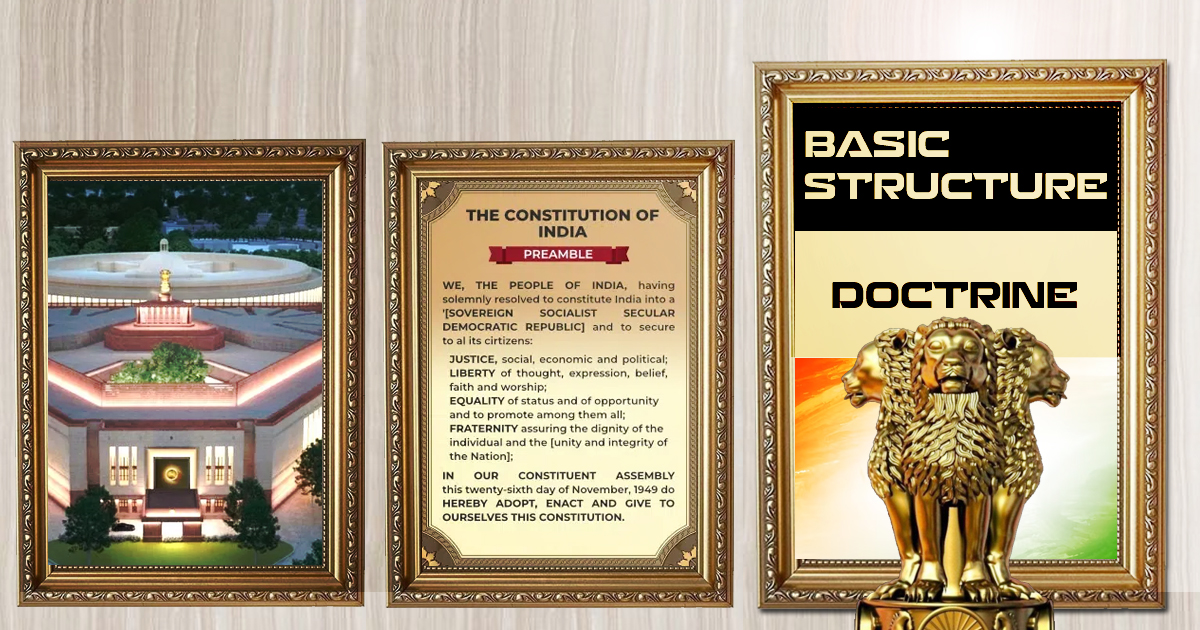Basic Structure
The Basic Structure Doctrine is a cornerstone principle established by the Indian Judiciary to ensure the inviolability of the fundamental character of the Indian Constitution.
This doctrine acts as a shield against attempts to radically alter the Constitution’s core tenets through amendments. Evolution of the Basic Structure Doctrine.
The doctrine wasn’t explicitly mentioned in the Constitution but emerged through a series of landmark Supreme Court judgments. Here’s a timeline of its development:
1950: The Constitution of India comes into effect.
1967: In the Sajjan Singh case, the Supreme Court hinted at the existence of limitations on Parliament’s power to amend the Constitution.
1973: The Kesavananda Bharati case established the Basic Structure Doctrine. By a 13-6 majority, the court ruled that Parliament’s power to amend under Article 368 is not absolute and cannot destroy the “basic structure” of the Constitution. However, the court did not define the exact content of this basic structure.
Supreme Court Cases Related to the Basic Structure Doctrine
Several subsequent cases have further clarified the scope of the Basic Structure Doctrine:
1975: Minerva Mills case: This case reaffirmed the Basic Structure Doctrine and elaborated on its components, including:
- Supremacy of the Constitution
- Federal character of the Constitution
- Secular character of the Constitution
- Democratic and republican form of government
- Separation of powers between the legislature, executive, and judiciary
- Fundamental Rights enshrined in Part III
1983: Waman Rao case: The court held that the basic structure also includes the power of judicial review.
These cases established a framework for determining the constitutionality of amendments. Any amendment that seeks to alter or abrogate these essential features is deemed unconstitutional.
Advantages of the Basic Structure Doctrine
The Basic Structure Doctrine offers several advantages:
Preserves the Constitution’s Core Values: It safeguards the fundamental principles upon which the Indian democracy is built.
Protects Fundamental Rights: By ensuring the inviolability of Part III, it guarantees the basic rights of citizens.
Maintains Continuity and Stability: It prevents abrupt changes to the Constitution’s framework, promoting stability and continuity in governance.
Promotes Judicial Review: It strengthens the judiciary’s role as the guardian of the Constitution.
Challenges and Obstacles
Despite its advantages, the doctrine faces certain challenges:
Undefined Scope: The exact contours of the “basic structure” remain somewhat ambiguous, creating room for potential debate and interpretation.
Judicial Overreach Concerns: Critics argue that the doctrine empowers the judiciary excessively, potentially encroaching upon the legislature’s amending power.
Dynamic Needs vs. Static Constitution: Balancing the need for the Constitution to adapt to changing social realities with the need for stability can be difficult.
How the Basic Structure Doctrine Safeguards Constitutional Principles
The doctrine operates in several ways to safeguard the Indian Constitution:
Limits Amending Power: It restricts Parliament from making amendments that fundamentally alter the Constitution’s character.
Protects Essential Features: It ensures the core principles of democracy, federalism, secularism, and fundamental rights remain intact.
Promotes Judicial Scrutiny: It empowers the judiciary to strike down amendments deemed violative of the basic structure.
Maintains Constitutional Continuity: It prevents drastic changes, preserving the established constitutional framework.
The doctrine serves as a crucial check and balance mechanism, ensuring that amendments serve to strengthen the Constitution rather than undermine its core values.
The Basic Structure Doctrine stands as a testament to the Indian judiciary’s role in safeguarding the Constitution. It serves as a shield against attempts to erode the fundamental principles of the Indian democracy.
However, the ongoing debate regarding its scope and limitations highlights the need for a nuanced understanding of this doctrine for effective governance and a vibrant democracy.
 Chinmaya IAS Academy – Current Affairs Chinmaya IAS Academy – Current Affairs
Chinmaya IAS Academy – Current Affairs Chinmaya IAS Academy – Current Affairs

